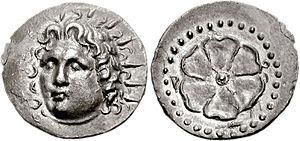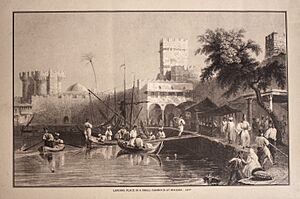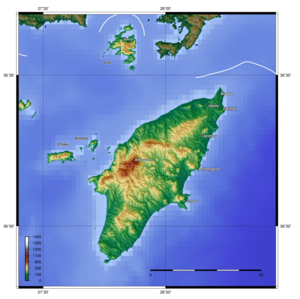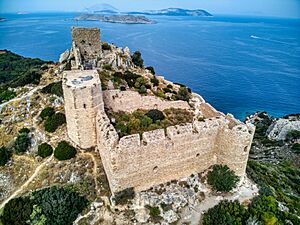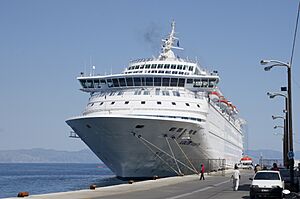Rhodes facts for kids
Quick facts for kids
Rhodes
Ρόδος
|
|||
|---|---|---|---|
|
Island and municipality
|
|||
 |
|||
|
|||
| Nickname(s):
Island of the Sun
|
|||

Location in the South Aegean administrative region of Greece
|
|||
| Country | |||
| Administrative region | South Aegean | ||
| Prefecture | Dodecanese | ||
| Regional unit | Rhodes | ||
| Seat | Rhodes | ||
| Area | |||
| • Total | 1,400.68 km2 (540.81 sq mi) | ||
| Highest elevation
(Attavyros)
|
1,216 m (3,990 ft) | ||
| Lowest elevation | 0 m (0 ft) | ||
| Population
(2021)
|
|||
| • Total | 125,113 | ||
| • Density | 89.3230/km2 (231.3456/sq mi) | ||
| Demonym(s) | Rhodian, Rhodiot or Rhodiote (rare) | ||
| Time zone | UTC+2 (EET) | ||
| • Summer (DST) | UTC+3 (EEST) | ||
| Postal codes |
851 00, 851 31, 851 32, 851 33 (for Rhodes town)
|
||
| Telephone | 2241, 2244, 2246 | ||
Rhodes (![]() i/roʊdz/; Greek: Ρόδος, romanized: Ródos [ˈroðos]) is the largest island in the Dodecanese group in Greece. It's also their historical capital. This beautiful island is the ninth largest in the Mediterranean Sea. Rhodes is a separate municipality within the Rhodes regional unit, which is part of the South Aegean administrative region. The main city, also called Rhodes, had about 50,636 people in 2011. By 2022, the island's population grew to 125,113 people. Rhodes is located northeast of Crete and southeast of Athens. It has many cool nicknames, like "Island of the Sun" because of its sun god, Helios. It's also called "The Pearl Island" and "The Island of the Knights," named after the Knights of Saint John, who ruled from 1310 to 1522.
i/roʊdz/; Greek: Ρόδος, romanized: Ródos [ˈroðos]) is the largest island in the Dodecanese group in Greece. It's also their historical capital. This beautiful island is the ninth largest in the Mediterranean Sea. Rhodes is a separate municipality within the Rhodes regional unit, which is part of the South Aegean administrative region. The main city, also called Rhodes, had about 50,636 people in 2011. By 2022, the island's population grew to 125,113 people. Rhodes is located northeast of Crete and southeast of Athens. It has many cool nicknames, like "Island of the Sun" because of its sun god, Helios. It's also called "The Pearl Island" and "The Island of the Knights," named after the Knights of Saint John, who ruled from 1310 to 1522.
Long ago, Rhodes was famous for the Colossus of Rhodes, one of the Seven Wonders of the Ancient World. Today, the Medieval Old Town of Rhodes City is a World Heritage Site. It's also one of Europe's most popular places for tourists.
Contents
- What's in a Name? The History of Rhodes' Name
- A Journey Through Time: The History of Rhodes
- Exploring the Geography of Rhodes
- Archaeology: Discovering Ancient Rhodes
- Religion: Faiths on Rhodes
- Economy: How Rhodes Makes Money
- Transportation: Getting Around Rhodes
- Sports: Staying Active on Rhodes
- Cuisine: Delicious Foods of Rhodes
- Notable People from Rhodes
- Tourism: Visiting Rhodes
- Panoramas
- Images for kids
- See also
What's in a Name? The History of Rhodes' Name
The island has always been known as Ρόδος (Ródos) in Greek. This name sounds a lot like the ancient Greek word for rose, ῥόδον (rhódon). In modern Greek, it also sounds like ρόδι (ródi), which means pomegranate. The island was also called Lindos (Ancient Greek: Λίνδος). In other languages, it's known as Rodi in Italian, Rodos in Turkish, and רודי (Rodi) or רודיס (Rodes) in Ladino.
Some older names for Rhodes were Ρόδη (Rodē), Τελχινίς (Telchinis), and Ηλιάς (Helias). One idea is that the name comes from erod, a Phoenician word for snake. This is because the island had many snakes in ancient times.
A Journey Through Time: The History of Rhodes
Ancient Times: Early Settlers and Myths
Life in the Neolithic Period
People lived on Rhodes even in the Neolithic period, which was a very long time ago. We don't have many remains from this early culture.
The Minoans Arrive
Around the 16th century BC, the Minoans came to Rhodes. Ancient Greek stories tell of a group called the Telchines living on Rhodes. The island was sometimes called Telchinis because of them.
Mycenaean Influence
In the 15th century BC, Mycenaean Greeks took over. After a period called the Bronze Age collapse, the first new contacts from outside were with Cyprus. Greek legends say that Rhodes even took part in the Trojan War, led by Tlepolemus.
The Archaic Era and New Cities
In the 8th century BC, new settlements began to form. The Dorians arrived and built three important cities: Lindus, Ialysus, and Camirus. These three, along with Kos, Cnidus, and Halicarnassus, formed the Dorian Hexapolis, which means "six cities."
A famous poet named Pindar wrote that the island was born from the sun god Helios and the nymph Rhodos. The three cities were named after their sons. The rhoda is a pink hibiscus flower that grows on the island.
Classical and Hellenistic Periods: Power and Culture
Persian Rule and Athenian Alliance
The Persians invaded Rhodes, but the forces from Athens defeated them in 478 BC. The cities of Rhodes then joined the Delian League, which was led by Athens. When the Peloponnesian War started in 431 BC, Rhodes stayed mostly neutral. By 404 BC, Rhodes had left the war and decided to become independent.
Rhodes was an important stop for Phoenician traders because it was at the eastern entrance to the Aegean Sea. This led to rich trading posts and Phoenician communities on the island.
Uniting the Cities and the Colossus
In 408 BC, the cities of Rhodes joined together to form one territory. They built a new capital, the city of Rhodes, at the northern end of the island. Its design was overseen by the Athenian architect Hippodamus.
Later, in 357 BC, King Mausolus of Caria conquered the island. Then, the Persians took control again in 340 BC, but not for long.
Alexander the Great and the Rise of Rhodes

In 332 BC, Rhodes became part of Alexander the Great's growing empire after he defeated the Persians. After Alexander died, his generals, called the Diadochi, fought for control. Rhodes formed strong business and cultural ties with the Ptolemies in Alexandria, Egypt. Together, they controlled trade across the Aegean Sea in the 3rd century BC.
The city of Rhodes became a major center for shipping, trade, and culture. Its coins were used almost everywhere in the Mediterranean. Rhodes had famous schools for philosophy, science, literature, and rhetoric. Many important thinkers taught there. Its sculptors developed a dramatic style, creating famous works like the Laocoön group.
In 305 BC, Demetrius, the son of Antigonus, tried to attack Rhodes to break its alliance with Egypt. Demetrius built huge siege engines, including a 180-foot battering ram and a siege tower called Helepolis that weighed 360,000 pounds. But in 304 BC, after only one year, he gave up and signed a peace agreement. He left behind a lot of military equipment. The people of Rhodes sold this equipment and used the money to build a giant statue of their sun god, Helios. This statue became known as the Colossus of Rhodes.
Rhodes and the Roman Republic
Throughout the 3rd century BC, Rhodes worked hard to stay independent and protect its trade, especially its control over the grain trade in the eastern Mediterranean. They used their strong economy and excellent navy to keep a balance of power among the big Hellenistic states.
By the end of the 3rd century BC, the balance of power was changing. Rhodes, along with other small states, asked the Roman Republic for help in 201 BC. The Romans agreed, and this led to the Second Macedonian War (200–196 BC), which Rome won. Rhodes kept its independence.
Rhodes became a "permanent ally" of Rome in 164 BC. This meant it was mostly under Rome's control, but still had some freedom. After this, Rhodes became a cultural and education center for Roman noble families. It was known for its teachers of rhetoric.
In the 1st century AD, the Emperor Tiberius lived in exile on Rhodes for a short time. It is also believed that Paul the Apostle visited the island and helped start an early Christian church there.
Byzantine Period: A Long Era of Change
When the Roman Empire split in 395 AD, Rhodes became part of the Byzantine Empire. This was a very long period for the island. From around 600 AD, Rhodes was known for its maritime laws, called "Rhodian Sea Law." These laws were used all over the Mediterranean.
In 654 AD, Umayyad forces from the Islamic empire captured Rhodes. They even took away the remains of the Colossus of Rhodes. The island was captured by Arabs again in 673. However, the Umayyads left in 679/80 after their fleet was destroyed.
From the early 8th to the 12th centuries, Rhodes was part of the Cibyrrhaeot Theme of the Byzantine Empire. It was a center for building ships and trade. Around 1090, the Seljuk Turks occupied it. But Emperor Alexios I Komnenos recaptured Rhodes during the First Crusade.
As the Byzantine Empire grew weaker, Rhodes became an independent area under Leo Gabalas and his brother John. Then, the Genoese occupied it from 1248 to 1250. The Genoese were later driven out, and Rhodes became a regular province of the Byzantine Empire again.
Knights and Ottomans: New Rulers

From 1306 to 1310, the Knights Hospitaller took over Rhodes. They were then called the "Knights of Rhodes." Under their rule, the city was rebuilt to be a perfect example of a European medieval city. Many famous buildings, like the Palace of the Grand Master, were built during this time.
The strong walls built by the knights helped them defend against attacks from the Sultan of Egypt in 1444. They also survived a siege by the Ottomans in 1480. However, Rhodes finally fell to the large army of Suleiman the Magnificent in December 1522. The Sultan had 400 ships and 100,000 men. The Knights, led by Grand Master Philippe Villiers de L'Isle-Adam, had about 7,000 men. The siege lasted six months. The surviving Knights were allowed to leave for the Kingdom of Sicily. The Knights later moved their base to Malta.
After this, Rhodes was part of the Ottoman Empire for almost 400 years.
Modern History: Italian Rule and Return to Greece
In 1912, Italy took Rhodes from the Ottomans during the Italo-Turkish War. This meant the island's people were not part of the "exchange of minorities" between Greece and Turkey. Rhodes and the other Dodecanese Islands were given to Italy in the Treaty of Ouchy. Although the treaty said the islands should go back to Turkey, World War I stopped this from happening. Turkey officially gave them to Italy with the 1923 Treaty of Lausanne. Rhodes then became the main part of Italy's possession called the Isole Italiane dell'Egeo.
Thousands of Italian colonists moved to the island, mostly to the capital, Rodi. In the late 1930s, Italy tried to spread Italian culture on the island. They improved the island's buildings and roads, constructing impressive places like the Hotel Rodon and the Puccini Theater.
After Italy surrendered in September 1943, the British tried to get the Italian soldiers on Rhodes to switch sides. But the German Army quickly occupied the island in the Battle of Rhodes.
On May 8, 1945, the Germans surrendered Rhodes and the Dodecanese to the British. The British then occupied the islands as a military protectorate.
At the Paris Peace Treaties in February 1947, Rhodes and the other Dodecanese islands were finally united with Greece. About 6,000 Italian colonists had to leave the island and return to Italy.
Rhodes Today: Recent Events
In 1949, Rhodes was where Israel and Egypt, Jordan, Lebanon, and Syria held talks. These talks led to the 1949 Armistice Agreements.
In 2023, the island faced large 2023 Greece wildfires. These fires caused the biggest evacuations in Greece's history, with nearly 19,000 people having to leave their homes.
Exploring the Geography of Rhodes
The island of Rhodes is shaped like a spearhead. It is about 79.7 kilometers (49.5 miles) long and 38 kilometers (24 miles) wide at its widest point. The total area is about 1,400 square kilometers (540 square miles), and its coastline is about 220 kilometers (140 miles) long. The main rock type is limestone. The city of Rhodes is at the northern tip of the island. This is where the old and new commercial harbours are located.
The main airport is Diagoras Airport, which is about 14 kilometers (9 miles) southwest of the city in Paradisi. Roads spread out from the city along the east and west coasts. Outside the city, you'll find small villages with whitewashed houses and spa resorts. Some of these are Faliraki, Lindos, and Archangelos.
Rhodes is about 363 kilometers (226 miles) east-southeast of mainland Greece. It is also only 18 kilometers (11 miles) from the southern coast of Turkey. Mount Attavyros is the island's highest point, standing at 1,216 meters (3,990 feet) tall.
Nature on Rhodes: Plants and Animals
Flora: The Plants of Rhodes
The middle of the island is mountainous and has few people. It is covered with forests of pine (Pinus brutia) and cypress trees. While the shores are rocky, the island has fertile strips of land. Here, farmers grow citrus fruits, wine grapes, vegetables, olives, and other crops. Many beautiful flowering plants, which the island is named after, grow here.
Fauna: The Animals of Rhodes
In 2005, scientists found that the fallow deer on Rhodes are special and unique. They are an important group to protect. In Petaloudes Valley, also known as "Valley of the Butterflies," many tiger moths gather during the summer months.
Earthquakes: Shaking the Island
Rhodes has experienced several earthquakes throughout history.
- The 226 BC earthquake destroyed the famous Colossus of Rhodes.
- On May 3, 1481, an earthquake destroyed much of Rhodes City.
- Another earthquake happened on June 26, 1926.
- On July 15, 2008, Rhodes was hit by a 6.3 magnitude earthquake. It caused minor damage to some old buildings and unfortunately, one person died.
Climate: Weather on the Island
Rhodes has a hot-summer Mediterranean climate. This means it has mild winters and hot summers. The southeast part of the island is much warmer. Lindos, for example, has an average yearly temperature of about 22.0°C (71.6°F), making it the warmest area in Greece. The Hellenic National Meteorological Service says that Southeast Rhodes also gets the most sunshine in Greece, with over 3,100 hours per year.
| Climate data for Rhodes Airport | |||||||||||||
|---|---|---|---|---|---|---|---|---|---|---|---|---|---|
| Month | Jan | Feb | Mar | Apr | May | Jun | Jul | Aug | Sep | Oct | Nov | Dec | Year |
| Record high °C (°F) | 22.0 (71.6) |
22.6 (72.7) |
27.6 (81.7) |
30.6 (87.1) |
34.8 (94.6) |
36.2 (97.2) |
39.0 (102.2) |
41.2 (106.2) |
35.4 (95.7) |
33.2 (91.8) |
28.4 (83.1) |
23.4 (74.1) |
41.2 (106.2) |
| Mean daily maximum °C (°F) | 15.1 (59.2) |
15.2 (59.4) |
17 (63) |
20.0 (68.0) |
24.1 (75.4) |
28.3 (82.9) |
30.4 (86.7) |
30.7 (87.3) |
28.1 (82.6) |
24.5 (76.1) |
20.2 (68.4) |
16.7 (62.1) |
22.5 (72.6) |
| Daily mean °C (°F) | 12.0 (53.6) |
12.0 (53.6) |
13.5 (56.3) |
16.3 (61.3) |
20.0 (68.0) |
24.2 (75.6) |
26.4 (79.5) |
26.7 (80.1) |
24.4 (75.9) |
20.7 (69.3) |
16.7 (62.1) |
13.5 (56.3) |
18.9 (66.0) |
| Mean daily minimum °C (°F) | 9.2 (48.6) |
9.1 (48.4) |
10.5 (50.9) |
13 (55) |
16.3 (61.3) |
20.4 (68.7) |
22.7 (72.9) |
23.2 (73.8) |
21 (70) |
17.4 (63.3) |
13.7 (56.7) |
10.8 (51.4) |
15.6 (60.1) |
| Record low °C (°F) | −4.0 (24.8) |
−1.6 (29.1) |
0.2 (32.4) |
5.2 (41.4) |
8.6 (47.5) |
12.6 (54.7) |
16.8 (62.2) |
17.0 (62.6) |
10.6 (51.1) |
7.2 (45.0) |
2.4 (36.3) |
1.2 (34.2) |
−4.0 (24.8) |
| Average rainfall mm (inches) | 151.8 (5.98) |
101.7 (4.00) |
68.9 (2.71) |
29.4 (1.16) |
16.4 (0.65) |
1.8 (0.07) |
0.3 (0.01) |
0.2 (0.01) |
6.3 (0.25) |
56.9 (2.24) |
89.6 (3.53) |
152.8 (6.02) |
676.1 (26.63) |
| Average rainy days | 15.5 | 12.7 | 10.5 | 7.6 | 4.6 | 1.2 | 0.2 | 0.1 | 1.5 | 6.7 | 9.5 | 15.4 | 85.5 |
| Average relative humidity (%) | 70.1 | 69.1 | 68.7 | 66.5 | 64.4 | 58.5 | 57.6 | 59.9 | 61.4 | 67.5 | 71.4 | 72.4 | 65.6 |
| Mean daily sunshine hours | 5.0 | 6.0 | 7.0 | 9.0 | 11.0 | 13.0 | 14.0 | 13.0 | 11.0 | 8.0 | 6.0 | 5.0 | 9.0 |
| Source 1: Hellenic National Meteorological Service (1955–2010 averages) | |||||||||||||
| Source 2: NOAA (1961–1977 temperatures taken from Maritsa Airport and 1977–1990 from Rhodes International Airport), Weather Atlas (sunshine data) | |||||||||||||
| Climate data for Rhodes Port 4 m a.s.l. | |||||||||||||
|---|---|---|---|---|---|---|---|---|---|---|---|---|---|
| Month | Jan | Feb | Mar | Apr | May | Jun | Jul | Aug | Sep | Oct | Nov | Dec | Year |
| Record high °C (°F) | 20.8 (69.4) |
20.9 (69.6) |
24.6 (76.3) |
27.6 (81.7) |
36.4 (97.5) |
37.9 (100.2) |
37.4 (99.3) |
37.6 (99.7) |
34.4 (93.9) |
32.6 (90.7) |
26.8 (80.2) |
22.2 (72.0) |
37.9 (100.2) |
| Mean daily maximum °C (°F) | 16.1 (61.0) |
16.4 (61.5) |
17.3 (63.1) |
20.2 (68.4) |
23.9 (75.0) |
27.2 (81.0) |
30.7 (87.3) |
30.5 (86.9) |
28.6 (83.5) |
25.5 (77.9) |
22.0 (71.6) |
18.4 (65.1) |
23.1 (73.5) |
| Daily mean °C (°F) | 14.0 (57.2) |
14.3 (57.7) |
15.1 (59.2) |
18.0 (64.4) |
21.4 (70.5) |
24.8 (76.6) |
28.0 (82.4) |
28.3 (82.9) |
26.5 (79.7) |
23.4 (74.1) |
19.9 (67.8) |
16.3 (61.3) |
20.8 (69.5) |
| Mean daily minimum °C (°F) | 11.9 (53.4) |
12.2 (54.0) |
12.9 (55.2) |
15.7 (60.3) |
18.9 (66.0) |
22.4 (72.3) |
25.3 (77.5) |
26.0 (78.8) |
24.4 (75.9) |
21.2 (70.2) |
17.7 (63.9) |
14.2 (57.6) |
18.6 (65.4) |
| Record low °C (°F) | 2.9 (37.2) |
4.7 (40.5) |
3.8 (38.8) |
9.4 (48.9) |
14.2 (57.6) |
16.2 (61.2) |
22.4 (72.3) |
23.1 (73.6) |
18.7 (65.7) |
17.1 (62.8) |
13.3 (55.9) |
9.0 (48.2) |
2.9 (37.2) |
| Average rainfall mm (inches) | 113.6 (4.47) |
58.5 (2.30) |
44.5 (1.75) |
19.2 (0.76) |
7.3 (0.29) |
7.5 (0.30) |
0.1 (0.00) |
0.3 (0.01) |
3.0 (0.12) |
26.7 (1.05) |
87.2 (3.43) |
144.1 (5.67) |
512 (20.15) |
| Mean monthly sunshine hours | 151.8 | 184.8 | 238.8 | 266 | 326.8 | 375.2 | 394.4 | 363.8 | 311.8 | 260.2 | 190.8 | 157.8 | 3,222.2 |
| Source 1: Municipal Port Fund of South Dodecanese (January 2019 – April 2024) | |||||||||||||
| Source 2: Sunshine Rhodes AP | |||||||||||||
| Climate data for Lindos 65 m a.s.l. | |||||||||||||
|---|---|---|---|---|---|---|---|---|---|---|---|---|---|
| Month | Jan | Feb | Mar | Apr | May | Jun | Jul | Aug | Sep | Oct | Nov | Dec | Year |
| Record high °C (°F) | 21.9 (71.4) |
24.8 (76.6) |
25.9 (78.6) |
32.4 (90.3) |
36.2 (97.2) |
43.6 (110.5) |
42.7 (108.9) |
43.1 (109.6) |
39.8 (103.6) |
37.9 (100.2) |
27.2 (81.0) |
22.5 (72.5) |
43.6 (110.5) |
| Mean daily maximum °C (°F) | 16.2 (61.2) |
17.1 (62.8) |
18.6 (65.5) |
22.5 (72.5) |
26.9 (80.4) |
31.8 (89.2) |
35.4 (95.7) |
35.0 (95.0) |
31.6 (88.9) |
26.7 (80.1) |
22.0 (71.6) |
18.3 (64.9) |
25.2 (77.3) |
| Daily mean °C (°F) | 13.6 (56.5) |
14.4 (57.9) |
15.7 (60.3) |
19.1 (66.4) |
23.2 (73.8) |
27.9 (82.2) |
31.4 (88.5) |
31.3 (88.3) |
28.2 (82.8) |
23.7 (74.7) |
19.4 (66.9) |
15.8 (60.4) |
22.0 (71.6) |
| Mean daily minimum °C (°F) | 11.1 (52.0) |
11.8 (53.2) |
12.8 (55.0) |
15.7 (60.3) |
19.5 (67.1) |
24.1 (75.4) |
27.4 (81.3) |
27.7 (81.9) |
24.8 (76.6) |
20.7 (69.3) |
16.8 (62.2) |
13.2 (55.8) |
18.8 (65.8) |
| Record low °C (°F) | 1.1 (34.0) |
3.3 (37.9) |
3.1 (37.6) |
9.4 (48.9) |
13.8 (56.8) |
16.8 (62.2) |
21.1 (70.0) |
24.0 (75.2) |
16.3 (61.3) |
13.1 (55.6) |
10.5 (50.9) |
4.3 (39.7) |
1.1 (34.0) |
| Average rainfall mm (inches) | 107.8 (4.24) |
70.9 (2.79) |
45.1 (1.78) |
10.8 (0.43) |
11.0 (0.43) |
2.5 (0.10) |
1.5 (0.06) |
0.04 (0.00) |
5.4 (0.21) |
24.7 (0.97) |
84.0 (3.31) |
117.4 (4.62) |
481.14 (18.94) |
| Average relative humidity (%) | 67.6 | 66.4 | 64.6 | 60.9 | 57.9 | 52.7 | 46.4 | 50.0 | 51.4 | 58.4 | 66.1 | 68.5 | 59.2 |
| Source 1: National Observatory of Athens (May 2014 – Jun 2024) | |||||||||||||
| Source 2: World Meteorological Organization | |||||||||||||
| Climate data for Rhodes | |||||||||||||
|---|---|---|---|---|---|---|---|---|---|---|---|---|---|
| Month | Jan | Feb | Mar | Apr | May | Jun | Jul | Aug | Sep | Oct | Nov | Dec | Year |
| Average sea temperature °C (°F) | 17.9 (64.2) |
17.0 (62.6) |
17.1 (62.8) |
17.6 (63.7) |
20.1 (68.2) |
23.4 (74.1) |
25.9 (78.6) |
27.2 (81.0) |
26.7 (80.1) |
23.8 (74.8) |
20.9 (69.6) |
18.8 (65.8) |
21.4 (70.5) |
| Mean daily daylight hours | 10.0 | 11.0 | 12.0 | 13.0 | 14.0 | 15.0 | 14.0 | 13.0 | 12.0 | 11.0 | 10.0 | 10.0 | 12.1 |
| Average Ultraviolet index | 2 | 3 | 5 | 7 | 8 | 10 | 10 | 9 | 7 | 5 | 3 | 2 | 5.9 |
| Source: Weather Atlas | |||||||||||||
Archaeology: Discovering Ancient Rhodes
The Colossus of Rhodes was one of the Seven Wonders of the Ancient World. This huge bronze statue once stood at the harbor. It was finished in 280 BC but was destroyed by an earthquake in 226 BC. No part of the statue remains today.
Other historical places on Rhodes include:
- The Acropolis of Lindos.
- The Acropolis of Rhodes with the Temple of Pythian Apollo.
- An ancient theater and stadium.
- Ancient Ialysos and ancient Kamiros.
- The Governor's Palace.
- The Rhodes Old Town (a walled medieval city).
- The Palace of the Grand Masters.
- Kahal Shalom Synagogue in the Jewish Quarter.
- The Archaeological Museum.
- The ruins of the castle of Monolithos.
- The castle of Kritinia.
- St. Catherine Hospice and Rhodes Footbridge.
Religion: Faiths on Rhodes
Christianity in Rhodes
The main religion on Rhodes is Greek Orthodox. The island is home to the Metropolis of Rhodes. There is also a small Latin Catholic community of 2,000 people. Many of them are descendants of Italians who stayed after the Italian occupation ended.
Islam in Rhodes
Rhodes has a Turkish Muslim community. This includes Greek Muslims whose ancestors converted to Islam during the Ottoman period. Unlike other Muslim groups in Greece, they were not forced to move to Turkey in 1923–24. This was because the Dodecanese Islands were under Italian rule at the time. The Turkish Association of Rhodes estimates their community to be around 3,500 people.
Judaism in Rhodes
The Jewish community on Rhodes has a history going back 2,300 years. The Kahal Shalom Synagogue, built in 1557 during the Ottoman era, is the oldest synagogue in Greece. It still stands in the Jewish quarter (La Juderia) of Rhodes' old town. In the 1920s, Jewish people made up one-third of the town's population. In the 1940s, there were about 2,000 Jews. Sadly, the Nazis deported and killed most of them during the Holocaust.
The Kahal Shalom synagogue has been restored with help from people outside Rhodes. However, few Jewish people live on Rhodes all year round today. The Jewish Museum of Rhodes was created in 1997 to keep the history and culture of Rhodes' Jews alive. It is next to the Kahal Shalom Synagogue.
Economy: How Rhodes Makes Money
The economy of Rhodes mostly relies on tourism. The service industry is the most developed part of the economy. Tourism has helped Rhodes become richer compared to other parts of Greece.
Small businesses on the island process raw materials that are brought in from other places. These goods are then sold locally. Other industries include making farm products, raising animals, fishing, and making wine.
Transportation: Getting Around Rhodes
Air Travel: Airports on the Island
Rhodes has two airports, but only one is open to the public. Diagoras Airport, southwest of Rhodes City, is the fourth busiest airport in Greece. It is the main way for both locals and tourists to enter and leave the island. The island has good connections to other major Greek cities and islands. It also connects to big European cities through charter flights.
Until 1977, Rhodes Maritsa Airport, built in 1938, was a public airport. Now, the Hellenic Air Force uses it. Sometimes, car races are held there. There are also two old airfields that are no longer used. Kalathos Airfield and Kattavia Airstrip were built by the Italians during Second World War.
Sea Travel: Ports of Rhodes
Rhodes has five ports. Three of them are in Rhodes City. One is on the west coast near Kamiros, and another is on the east coast near Lardos.
- Central Port: This port in Rhodes City is only for international travel. It has scheduled services to Turkey, cruise ships, and yachts. Since 2012, it has also been a homeport for Costa Cruises in the summer.
- Kolona Port: This port is across from and north of the central port. It serves traffic between the Dodecanese islands and yachts of all sizes.
- Akandia Port: This is the island's newest port, located south of the central port. It has been under construction since the 1960s. It is used for domestic travel, cargo, and general purposes. Since summer 2017, a passenger terminal with a cafe and waiting areas has been in use.
- Mandraki Port: This is the oldest port on the island, in the center of Rhodes City. Many cruise boats start their daily trips here to Symi island or to the southeastern coast towards Lindos.
- Kamiros Skala Dock: This dock is 30 kilometers (19 miles) southwest of the city, near the ancient Kamiros ruins. It mainly serves the island of Halki.
- Lardos Dock: This port used to serve local industries. Now, it is being developed as an alternative port for when the central port cannot be used due to bad weather. It is on a rocky shore near the village of Lardos in southeast Rhodes.
Road Network: Driving Around Rhodes
Most of the roads on Rhodes are paved. The island has 3 national roads, 40 provincial roads, and many local roads. Here are the four main roads:
- Rhodes-Kamiros Province Avenue: This road runs along the west coast from north to south. It connects Rhodes City with Diagoras Airport and Kamiros.
- Rhodes-Lindos National Avenue (Greek National Road 95): This road runs mostly inland from north to south. It connects Rhodes City with Lindos. Part of it is four lanes, and the rest is two lanes.
- Rhodes-Kallithea-Faliraki Province Avenue 4: This two-lane road runs along the east coast from north to south. It connects Rhodes City with the Kallithea monument and Faliraki Resort.
- Tsairi-Airport National Avenue (Greek National Road 100): This road runs inland from east to west. It connects the east coast with the west and the airport.
- Lindos-Katavia Province Road 1: This two-lane road starts near Lindos and goes through villages and resorts to Katavia village. From there, another road leads to Prasonissi.
- Rhodes Town Ring Road (Phase 1): This is a four-lane expressway that starts from the new marina.
Bus Services: Public Transport
Bus services on Rhodes are run by two companies:
- RODA: This is the municipal bus company. It serves Rhodes City and nearby areas like Faliraki and the west coast.
- KTEL: This is a private transport company. It serves villages and resorts on the east coast of the island.
Cars and Motorbikes: Island Traffic
Many families in Rhodes own more than one car and a motorbike. Traffic jams are common, especially in the summer. This is because the number of vehicles more than doubles. Parking spots in downtown Rhodes and around the old town are limited. The island also has 450 taxis and about 200 public and private buses, which add to the traffic.
Sports: Staying Active on Rhodes
- Football: AS Rodos and Diagoras F.C. are the island's biggest football teams and rivals. Many stadiums on the island have grass fields.
- Basketball: Colossus BC is a professional basketball team. They have played in Greece's top league for over ten years. There are several indoor basketball courts on the island.
- Volleyball: Rodion Athlisis is a local volleyball team that has competed at the national level.
- Water Polo: This sport is mostly played by amateurs. There isn't a public indoor pool on the island.
- Rugby: Rugby was introduced in 2007. Teams from Rhodes compete at the national level.
- Tennis: The Rhodes Tennis Club has been promoting tennis since 1949. The club has two locations.
- Sailing: The island has competed in sailing at an international level.
- Cycling: For a long time, Rhodes had the only velodrome (a track for cycling) in Greece. The island hosts the International Tour of Rhodes, which is a cycling event.
- Rhodes also hosted the Island Games in 2007.
Cuisine: Delicious Foods of Rhodes
Rhodes has a rich tradition of local foods. Koriantolino and Souma (a clear alcoholic drink made from grapes) are the main alcoholic drinks.
Some local foods include:
- Escharitis, a type of bread.
- Pitaroudia, chickpea dumplings.
- Milla and Tsiriggia, types of meat fat.
- Pougia pie.
- Lakani, goat meat with chickpeas.
- Lópia (beans) with goat.
- Matsi, handmade pasta used for a traditional recipe called Koulouría.
- Synoro, a traditional cheese.
- Tahinopita, a sweet pastry.
- Zvigoi, a type of loukoumades (fried dough balls).
- Melekouni, a honey-sesame candy.
- Fanouropita, a cake.
- Takakia (Mantinades).
- Katimeria (tiganites, which are like pancakes).
- Amygdalota, white almond cookies.
- Moschopougia.
Notable People from Rhodes
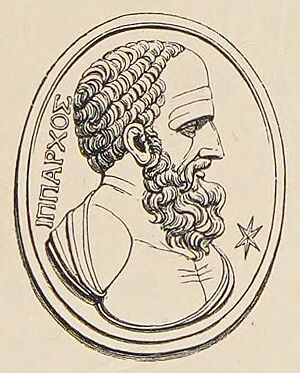

- Agesander of Rhodes (1st century BC), a sculptor.
- Apollonius Molon (fl. 70s BC), a Greek rhetorician who taught famous students like Marcus Tullius Cicero.
- Apollonius of Rhodes (3rd century BC), an epic poet.
- Chares of Lindos (3rd century BC), a sculptor.
- Cleobulus of Lindos (6th century BC), a philosopher and one of the Seven Sages of Ancient Greece.
- Dinocrates (4th century BC), an architect for Alexander the Great.
- Hecato of Rhodes (c. 100 BC), a Stoic philosopher.
- Hieronymus of Rhodes, (c.290-c.230 BC), a Peripatetic philosopher.
- Hipparchus, (2nd century BC), an astronomer, mathematician, and geographer. He founded trigonometry.
- Joannicius II of Constantinople, (died 1659) Ecumenical Patriarch of Constantinople.
- Memnon of Rhodes (380–333 BC), a commander of a mercenary army.
- Mentor of Rhodes (385–340 BC), a mercenary soldier, brother of Memnon.
- Panaetius (c. 185 – c. 110/109 BC), a Stoic philosopher.
- Timocreon (5th century BC), a poet.
And more recent notable people:
- Argy DJ (living), a Greek DJ and music producer.
- Lawrence Durrell (1912–1990), a writer and poet, who lived on Rhodes from 1945–1947.
- Reşit Galip (1893–1934), a Turkish politician.
- Ferruccio Lamborghini (1916–1993), an Italian automobile designer, who was stationed on the island during WW2.
- George Marshall (1781–1855), an author and Master Gunner in the United States Navy.
- Murat Reiz Plaku (1534–1609), an Albanian Navy Commander and Ottoman privateer.
- Panagiotis Rodios (1789-1851), a revolutionary and Hellenic Army officer.
- Ioannis Zigdis (1913–1997), a politician and economist.
Sports Stars from Rhodes
- Diagoras of Rhodes (5th century BC), a boxer and multiple Olympic winner.
- Leonidas of Rhodes (2nd century BC), an athlete.
And more recent sports stars:
- Braith Anasta (born 1982), a rugby league player.
- Stergos Felegakis (born 1986), a professional football player.
- Nick Galis (born 1957), a basketball player and Hall of Fame member.
- Niki Xanthou (born 1973), a long jumper.
Tourism: Visiting Rhodes
Rhodes is one of the most popular places for tourists in Greece. After Crete, it's the most visited spot. In 2013, 1,785,305 people visited. In 2014, that number grew to 1,931,005. In 2015, it was slightly less at 1,901,000. On average, visitors stay for about 8 days. Most tourists come from Great Britain, Israel, France, Italy, Sweden, and Norway. Rhodes has many places to stay, with over 550 hotels. Most of these are two-star hotels.
Panoramas
Images for kids
See also
 In Spanish: Rodas para niños
In Spanish: Rodas para niños









